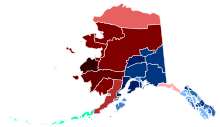
| Census | Pop. | Note | %± |
|---|---|---|---|
| 1880 | 33,426 | — | |
| 1890 | 32,052 | −4.1% | |
| 1900 | 63,592 | 98.4% | |
| 1910 | 64,356 | 1.2% | |
| 1920 | 55,036 | −14.5% | |
| 1930 | 59,278 | 7.7% | |
| 1940 | 72,524 | 22.3% | |
| 1950 | 128,643 | 77.4% | |
| 1960 | 226,167 | 75.8% | |
| 1970 | 300,382 | 32.8% | |
| 1980 | 401,851 | 33.8% | |
| 1990 | 550,043 | 36.9% | |
| 2000 | 626,932 | 14.0% | |
| 2010 | 710,231 | 13.3% | |
| 2020 | 733,391 | 3.3% | |
| 1930 and 1940 censuses taken in preceding autumn Sources: 1910–2020[1] | |||

As of 2020, Alaska has a population of 733,391.
In 2005, the population of Alaska was 663,661, which is an increase of 5,906, or 0.9%, from the prior year and an increase of 36,730, or 5.9%, since the year 2000.[2] This includes a natural increase since the last census of 36,590 people (53,132 births minus 16,542 deaths) and an increase due to net migration of 1,181 people into the state. Immigration from outside the United States resulted in a net increase of 5,800 people, and migration within the country produced a net loss of 4,619 people. More than half of the state's population lives in Anchorage, Juneau and Fairbanks, with two-fifths in Anchorage alone. The Matanuska-Susistna Borough is one of the nation’s fastest growing areas, with an estimated population of 100,000 and projections of 130,000 by 2027.[3] The last census of the Matanuska-Susitna Borough in 2019 showed a population of 108,317.[4] The Matanuska-Susitna Borough contains the incorporated townships of Wasilla and Palmer and is home to an indigenous population, The Dena'ina people have been in the area for 10,000 years. Knik Tribal Council is a federally recognized tribe in the MAT-SU and a non-profit social service organization for Natives in the MAT-SU region.[5] This area contains the cities of Meadow Lakes, Big Lake, Houston, Talkeetna, Willow. There are 54 cities, townships and other populated areas in the Matanuska-Susistna Borough.[6]
With a population of 733,391, according to the 2020 U.S. census,[7] Alaska is the 49th most populous and least densely populated state.
For purposes of the federal census, the state is divided into artificial divisions defined geographically by the United States Census Bureau for statistical purposes only.
The center of population of Alaska is located approximately 64.37 kilometers (40.00 mi) east of Anchorage at 61.399882 N. latitude, -148.873973 W. longitude.[8] In 2006, Alaska had a larger percentage of tobacco smokers than the national average, with 24% of Alaskan adults smoking.[9]
- ^ "Historical Population Change Data (1910–2020)". Census.gov. United States Census Bureau. Archived from the original on April 29, 2021. Retrieved May 1, 2021.
- ^ "Graphical Library of Demographic Change in Arctic Alaska". Retrieved 7 July 2018.
- ^ "Matanuska Susitna Borough/Business/A Haven for Commercial and Industrial Development and Small Business". Retrieved 2 August 2021.
- ^ "QuickFacts Matanuska-Susitna Borough, Alaska". Retrieved 2 August 2021.
- ^ "Borough respects Knik Tribal Council's wishes". Retrieved 2 August 2021.
- ^ "Matanuska-Susitna Borough AK Cities, Towns, & Neighborhoods". Retrieved 2 August 2021.
- ^ U.S. Census Bureau. (2001-04-02). "Census 2000 PHC-T-2. Ranking Tables for States: 1990 and 2000. Table 1. States Ranked by Population: 2000." U.S. Census Bureau, Population Division. Retrieved on 2007-06-12.
- ^ Population and Population Centers by State: 2010. United States Census Bureau. Retrieved February 5, 2017.
- ^ CDC's STATE System - State Comparison Report Cigarette Use (Adults) – BRFSS[permanent dead link] for 2006, lists Alaska as having 24.2% smokers. The national average is 20.8% according to Cigarette Smoking Among Adults-United States, 2006 article in the CDC's Morbidity and Mortality Weekly Report.